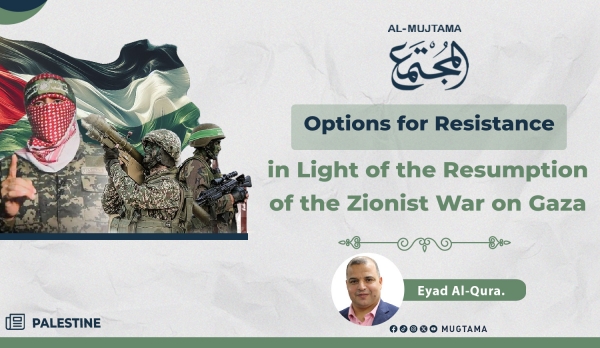What are the methods used by the resistance to deal with Israel's escalation?
With the resumption of "Israeli" escalation and the continuation of the war on the Gaza Strip, the Palestinian resistance enters a new and highly complex phase, which necessitates a careful review of its strategic options in light of changing political, military, and humanitarian circumstances.
The experience over more than a year and a half of confrontation has proven that resistance, in its comprehensive sense, is still capable of imposing a high cost on the occupation, whether at the operational, security, economic, or psychological levels within the "Israeli" domestic front.
Although the options before the resistance may seem difficult and fraught with dangers, it possesses the tools, experience, and flexibility to manage the upcoming phase with awareness and advanced tactics, especially with the occupation continuing its aggressive approach and its efforts to break the Palestinian will by targeting both the military structure and the social structure simultaneously.
First: The reality of the confrontation one and a half years after the war:
The Palestinian resistance has engaged in one of the longest and most complex confrontations with the "Israeli" occupation since October 7, 2023. In this conflict, despite significant losses, the resistance has succeeded in:
- Unprecedented disruption of the 'Israeli' internal front
- Undermining the prestige of the Zionist army on several fronts
- Proving the existence of military infrastructure that is still operational despite bombing and destruction.
- Exposing the international stance for its duplicity in the face of massacres and violations.
But the war has not stopped yet, and the scene does not suggest that a permanent settlement is near, which requires the resistance to make a careful reading of the upcoming stage.
Read also: Exploring the fractures and disputes within the Zionist entity
Secondly: The goals of the occupation in resuming the war:
It seems that the occupation, led by Netanyahu's extremist government, is not only seeking to recover its prisoners or impose a ceasefire on its own terms, but is moving towards broader objectives, which are represented in:
- The attempt to dismantle the military structure of the resistance, especially "Hamas," through focused strikes on tunnels and field leaders.
- The disarmament file was raised as part of the ceasefire conditions, in an attempt to dismantle the resistance project from its roots.
- The popular resistance's incubator is being struck by deepening the humanitarian disaster.
- Political arrangements in Gaza that exclude the resistance and reshape the security and civil landscape.
These objectives place the resistance in front of complex choices, ranging from open confrontation to political maneuvering without compromise.
Read also: Resistance Weapon... A Power Equation at the heart of Negotiation
Thirdly: Options for resistance against the occupation:
- The open comprehensive confrontation.
This option means returning to intense ground fighting, through:
- Resumption of rocket fire into the depth of 'Israel'
- The use of offensive tunnels to target occupation bases and sites.
- Expanding the scope of field engagement on multiple fronts within the sector.
- Executing qualitative operations behind enemy lines.
- Despite the high cost of this option, the resistance has proven that it has not been defeated militarily, and that what has been destroyed does not exceed 30-40% of its capabilities, especially in the area of tunnels
But this scenario faces significant challenges, the most notable of which are:
- The deteriorating humanitarian situation inside Gaza.
- The need to reposition and fill the operational gaps after the martyrdom of several leaders.
- International pressures and attempts to contain the escalation.
- Political maneuvering while retaining weapons.
It is an option that involves positively engaging with certain negotiation initiatives, without making strategic concessions, particularly regarding weapons.
Resistance here can:
- Agree to a limited or temporary ceasefire, conditional on stopping the aggression and lifting the blockade.
- It ensured the maintenance of its weapon without publicly demonstrating its use.
- It provides space for international and Arab efforts while maintaining a state of readiness.
This option enables the resistance to reorganize its ranks and consolidate its achievements, without being drawn into uneven battles amidst difficult humanitarian conditions.
- Acceptance of a civilian administration that is not resistant to Gaza
More than once, and through the statements of Palestinian and Arab leaders, recent international initiatives have been announced that propose the establishment of a civilian administration for Gaza that is not linked to the resistance, under the sponsorship of regional parties or with international funding.
If these proposals are presented as a humanitarian solution, the resistance may find itself facing a highly sensitive equation: not engaging publicly, without accepting marginalization.
This option carries clear risks, the most prominent of which are:
- The hollowing out of resistance politically and in the media.
- The gradual loss of control over the security scene.
- Create a fragile alternative model that takes Gaza back to before 2006.
Therefore, if the resistance chooses to engage with this hypothesis, it must set clear red lines, the most prominent of which are not to touch the weapons, the right of resistance, and to reject any administration that serves as a gateway to guardianship or the removal of decision-making.
- The option of a long-term truce without disarmament:
Some international powers have proposed a scenario for a long-term ceasefire (5-10 years) in exchange for halting military operations, opening crossings, and starting reconstruction, without any declared conditions regarding weapons.
This scenario could be presented as a humanitarian opportunity to save what remains of the infrastructure and revive the sector.
But it carries complex challenges:
- The possibility of the long ceasefire turning into a final political closure.
- The dangers of reducing the operational readiness of the resistance due to relaxation.
- The possibility of the occupation using the ceasefire to reposition and plan for a later, more dangerous phase.
- If the resistance accepts this scenario, it must maintain its full combat readiness and invest the calm in developing its military structure.
- The guarantees demanded by the resistance:
In light of the long experience with occupation, the resistance has begun to demand clear guarantees for any agreement, whether it is a ceasefire, a prisoner exchange, or a political arrangement. Among these guarantees:
- A comprehensive cessation of hostilities, not just a fragile truce.
- Not returning to war after the release of prisoners
- Completely lifting the siege and opening the crossings without political control.
- Do not touch the weapon under any humanitarian or economic pretext
These guarantees are not a political luxury, but rather a foundation for protecting the blood of the Palestinian people, their achievements, and the trust of the masses in the resistance project.
- The most likely scenario... biting of the fingers:
At the current stage, it seems that the resistance is leaning towards a “game of chicken” strategy; that is, holding firm to its position and forcing the occupation to gradually retreat through simultaneous political and field pressure.
Where Netanyahu wants the head of the resistance, either through force or popular isolation, the reality proves that the resistance remains cohesive, enjoys a strong base of support, and manages the negotiation battle without losing its leverage.
The Palestinian resistance is facing a complex phase, but it is not without options, ranging from full escalation to political maneuvering, or accepting a tactical settlement. The resistance has many cards to play, a history of resilience, and field experience that qualifies it to manage the challenge rather than submit to it.
Therefore, what is required today is to manage the battle with the mind before the rifle, with steadfastness before escalation, without compromising fundamental principles or sliding towards concessions.
In the end, resistance remains the last hope for a people seeking dignity and a homeland that cannot be reduced to a ceasefire or a humanitarian corridor, but rather to a complete liberation project that cannot be disrupted by negotiations.


